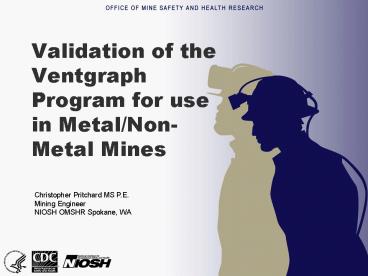Validation of the Ventgraph Program for use in Metal/Non-Metal Mines - PowerPoint PPT Presentation
1 / 28
Title:
Validation of the Ventgraph Program for use in Metal/Non-Metal Mines
Description:
... Description of 1972 Sunshine Mine and Fire Event Recreating the ventilation network Modeling network and mine fire Model verification What If Scenarios ... – PowerPoint PPT presentation
Number of Views:363
Avg rating:3.0/5.0
Title: Validation of the Ventgraph Program for use in Metal/Non-Metal Mines
1
Validation of the Ventgraph Program for use in
Metal/Non-Metal Mines
Christopher Pritchard MS P.E. Mining
Engineer NIOSH OMSHR Spokane, WA
2
Summary
- Introduction
- Description of 1972 Sunshine Mine and Fire Event
- Recreating the ventilation network
- Modeling network and mine fire
- Model verification
- What If Scenarios
- Summary and Conclusions
3
Introduction
- NIOSH Research Plan - 2008
- Reduce incidents and severity of fires in M/NM
Mines - Increase understanding of products of combustion
- Improve ventilation and escape planning
- Investigate and choose ventilation software
- Verify by using actual M/NM mine fire incident
4
Ventilation Software Requirements
- Mine Fire simulation capabilities
- Real time
- Non-compressible flow
- NVP
- Graphics
- Choice Ventgraph for Windows
5
Fire 1972 Sunshine Mine
- Historically significant
- Deep
- Complicated ventilation system
- Compressed air injection
- Multiple fans
- Drastic changes to ventilation system
6
Previous Sunshine Work
- 1977 USBM Report Hall/Ramani/Greuer
- Network model only
- Semi NVP
- No fire
- No contaminants
- No graphics
7
Sunshine Ventilation System
8
1972 Fire Event
- 1140 am Smoke detected 3700L _at_ No. 10 Shaft
- 1200 Mine evacuation begun by 3100L route,
surface notified, 3700L fire door closed at
Jewell Shaft - 1245 last survivors hoisted to 3100L _at_10 SH,
100 last hoist run. - 115 No. 12 SH cover removed
9
Fire and Evacuation Sequence
10
Sunshine Pictures
Jewell Shaft entrance
Workings
11
Sunshine Pictures
Stope
10 Shaft Hoist at 3100 Level
12
Sunshine Pictures
No. 8 Shop area smoke detected
Blue Room 3700 Level
13
Sunshine Pictures
3700 Level 910R fire site
Fire Site in raise
14
Modeling Process
- Airway data from 1977 USBM report
- Scale airways from JW Andrews Sunshine maps
- Temperature data from USBM vent survey Fall,
1971 - Barometric data from mine elevations
15
Modeling Development
- Initial run 1.6 accuracy with USBM
- Fire location 910 Raise between 3100 and 3700
level - Bulkhead failure sequence
- Problem with 3400 booster fan, redo with fan
curve, 3.3 accuracy
16
Calibrate Model to Fire Events
- Key events
- 1135 am Smoke 3700 level
- 1200 smoke observed at surface
- 1210 smoke leaks into 3100 level
17
Fire Model Events
- Fire sequence model
- 1105 am wood fire 910R, 65m long, ramp up time 5
minutes to Level 10 - 1110 fire to 100m, 910R Bulkhead partially
failed, 08 Shop door open - 1115 fire to 200m, 910R BH further failure
- 1120 fire constant, 910R BH wide open
18
(No Transcript)
19
Ventgraph Output
Smoke at approximate time of discovery 1140 am
20
Ventgraph Output
Local Detail of Fire Area CO Levels at 1140 am
21
Verification
- Model - good correlation to observed smoke
arrival times - CO levels correlate well to escaping miner
behavior - Results of model give confidence to analyzing
alternatives - Run What-If Scenarios
22
What-If Scenarios
- Turn off 3400 Level Booster Fans
- Problem with implementation of task
- What-If Stop fan 1235 pm
- Clears most 3100 roadway in 15 min
- CO still high at 3100L hoist for 80 min
- Did not effect lower mine CO levels
- Would more 1245 cage miners survive?
- Allow rescuers to reach 3100L hoist more quickly?
23
What-If Scenarios
- Jewell Fire Door Closure Sequence
- Supervisors underground made best decision
close 3700L door. - Close 3100L door evacuating miners perish,
lower levels may survive longer - Best option - leave both doors open and shut down
3400L booster fans
24
What-If Scenarios
- Opening No. 12 Shaft cover earlier
- Slight improvement in airflow to 4800L 0.9 2.1
m3/s - Essentially no difference to any other area of
the mine
25
What-If Scenarios
- Placement of bulkheads
- Aid fire fighting
- Simulation short term accurate
- Fire can endanger mine infrastructure
- Planning may minimize damage
- Sunshine no combo of booster/doors works
- Stopping needed to be installed inby 910R (and
fire) to be effective
26
Summary/Conclusions
- Ventgraph validated in Sunshine Scenario
- NVP
- Multiple fans
- Leakage
- Recirculation
- CO levels
- Issues/Problems
- Ventgraph fire Intensity Levels
- Booster fan flow deviation w/USBM model
27
Summary/Conclusions
- 3400 Level booster fan decision
- Contributed to 1977 MSHA ACT
- Valuable modeling/training tool
- Use before and during event
Survivors Tom Wilkinson and Ron Flory
28
NIOSH - OMSHRSpokane
Questions or Comments? CPritchard_at_cdc.gov 509-354-
8021































